fuel TOYOTA LAND CRUISER 2010 J200 Owners Manual
[x] Cancel search | Manufacturer: TOYOTA, Model Year: 2010, Model line: LAND CRUISER, Model: TOYOTA LAND CRUISER 2010 J200Pages: 592, PDF Size: 7.98 MB
Page 2 of 592

TABLE OF CONTENTSIndex
2
L/C200_U
1-1. Key informationKeys ..................................... 24
1-2. Opening, closing and locking the doors
Smart key system................. 26
Wireless remote control ....... 39
Side doors ............................ 42
Back door ............................. 47
1-3. Adjustable components (seats, mirrors,
steering wheel)
Front seats ........................... 52
Rear seats ............................ 54
Driving position memory system ................................ 63
Head restraints ..................... 67
Seat belts ............................. 71
Steering wheel ..................... 80
Inside rear view mirror.......... 82
Outside rear view mirrors ..... 83
1-4. Opening and closing the windows and moon roof
Power windows .................... 86
Moon roof ............................. 89
1-5. Refueling Opening the fuel tank cap .... 92 1-6. Theft deterrent system
Engine immobilizer system ................................ 96
Alarm .................................... 98
1-7. Safety information Correct driving posture ....... 101
SRS airbags ....................... 103
Front passenger occupant classification system ......... 118
Child restraint systems ....... 124
Installing child restraints ..... 128
2-1. Driving procedures Driving the vehicle .............. 142
Engine (ignition) switch....... 152
Automatic transmission ...... 156
Turn signal lever ................. 161
Parking brake ..................... 162
Horn .................................... 163
2-2. Instrument cluster Gauges and meters ............ 164
Indicators and warning lights ................................. 167
Multi-information display ..... 170
2-3. Operating the lights and wipers
Headlight switch ................. 174
Fog light switch ................... 176
1Before driving
2When driving
Page 5 of 592
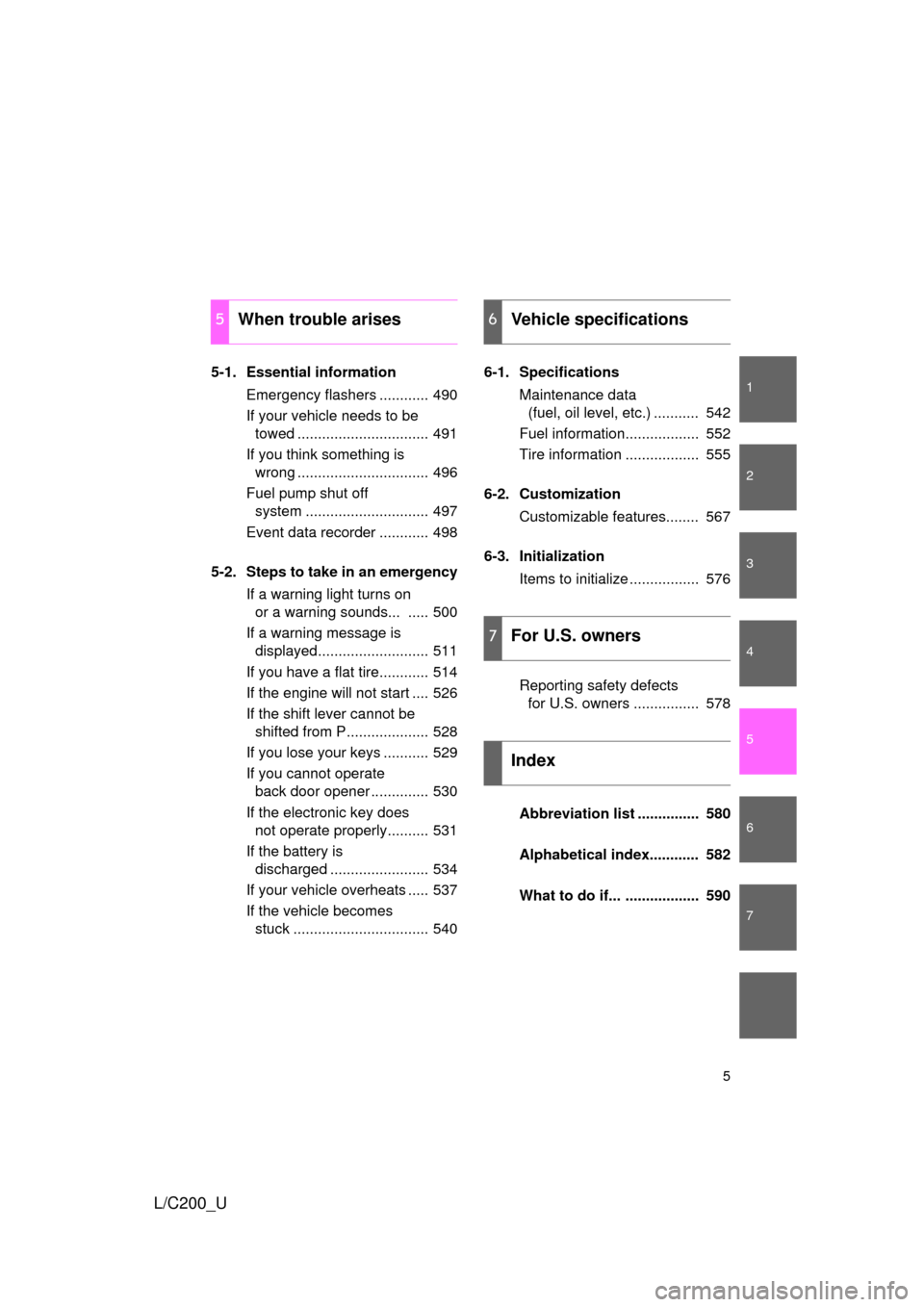
1
2
3
4
5
6
7
5
L/C200_U
5-1. Essential informationEmergency flashers ............ 490
If your vehicle needs to be towed ................................ 491
If you think something is wrong ................................ 496
Fuel pump shut off system .............................. 497
Event data recorder ............ 498
5-2. Steps to take in an emergency If a warning light turns on or a warning sounds... ..... 500
If a warning message is displayed........................... 511
If you have a flat tire............ 514
If the engine will not start .... 526
If the shift lever cannot be shifted from P.................... 528
If you lose your keys ........... 529
If you cannot operate back door opener .............. 530
If the electronic key does not operate properly.......... 531
If the battery is discharged ........................ 534
If your vehicle overheats ..... 537
If the vehicle becomes stuck ................................. 540 6-1. Specifications
Maintenance data (fuel, oil level, etc.) ........... 542
Fuel information.................. 552
Tire information .................. 555
6-2. Customization Customizable features........ 567
6-3. Initialization Items to initialize ................. 576
Reporting safety defects for U.S. owners ................ 578
Abbreviation list ............... 580
Alphabetical index............ 582
What to do if... .................. 590
5When trouble arises6Vehicle specifications
7For U.S. owners
Index
Page 7 of 592
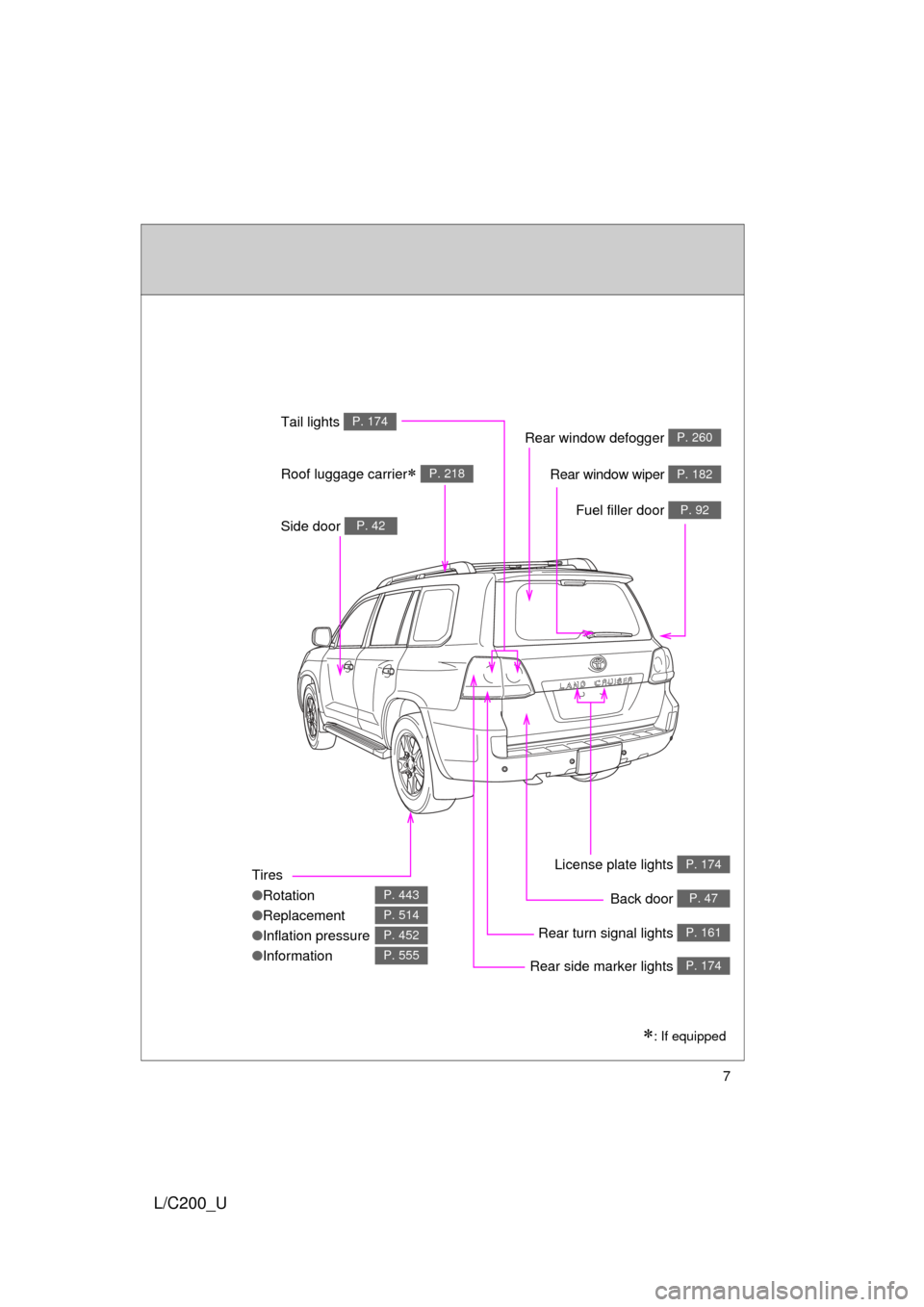
7
L/C200_U
Tires
●Rotation
● Replacement
● Inflation pressure
● Information
P. 443
P. 514
P. 452
P. 555
Rear window defogger P. 260
Rear window wiper P. 182
Tail lights P. 174
Side door P. 42
Rear turn signal lights P. 161
License plate lights P. 174
Roof luggage carrier P. 218
Back door P. 47
: If equipped
Fuel filler door P. 92
Rear side marker lights P. 174
Page 12 of 592
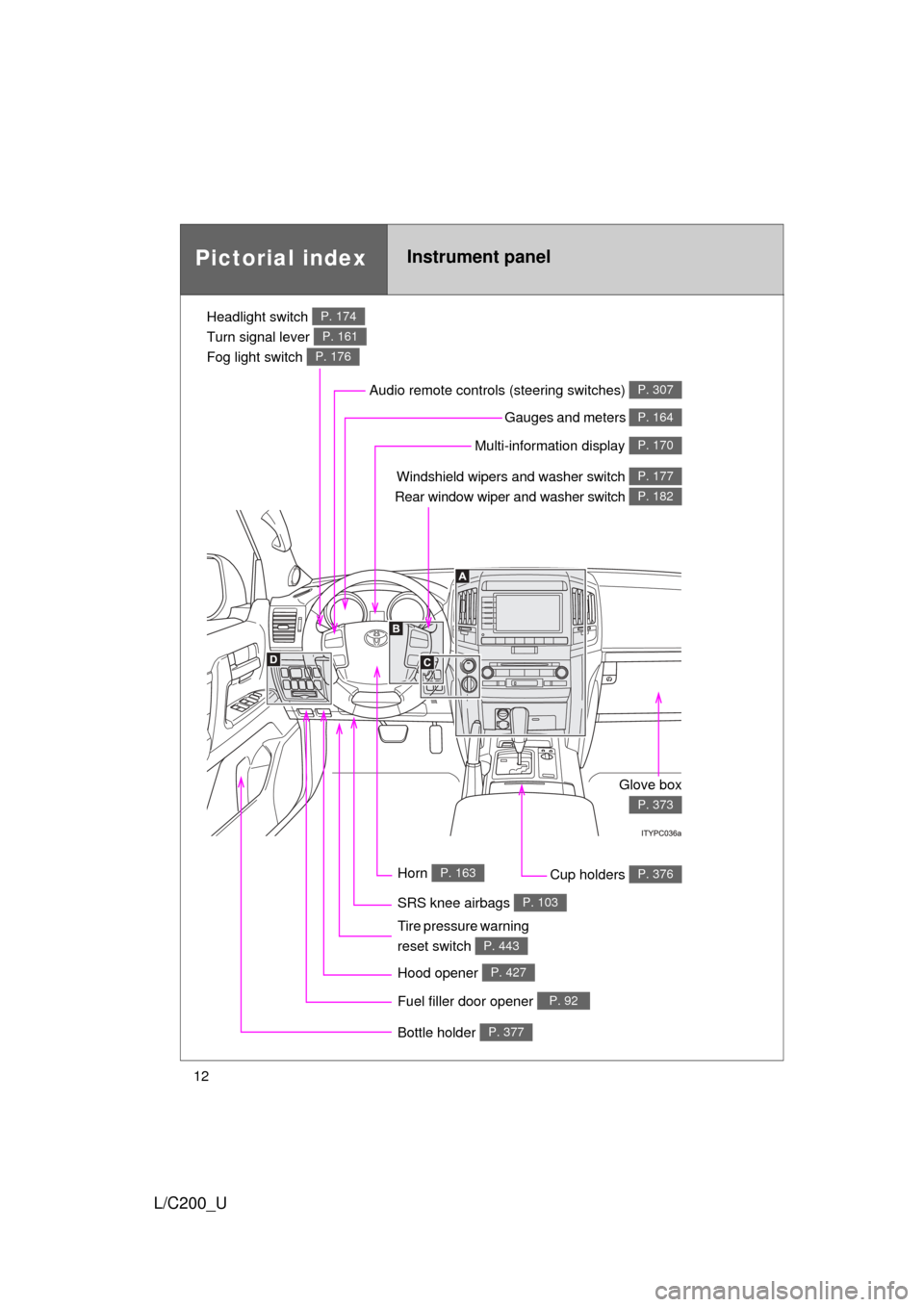
12
L/C200_U
Pictorial indexInstrument panel
Headlight switch
Turn signal lever
Fog light switch P. 174
P. 161
P. 176
Windshield wipers and washer switch
Rear window wiper and washer switch P. 177
P. 182
Gauges and meters P. 164
Glove box
P. 373
Fuel filler door opener P. 92
Hood opener P. 427
SRS knee airbags P. 103
Tire pressure warning
reset switch
P. 443
Cup holders P. 376
Multi-information display P. 170
Audio remote controls (steering switches) P. 307
Bottle holder P. 377
Horn P. 163
Page 18 of 592

18
L/C200_U
For your information
Main Owner’s Manual
Please note that this manual applies to all models and explains all equip-
ment, including options. Therefore, you may find some explanations for
equipment not installed on your vehicle.
All specifications provided in this manual are current at the time of printing.
However, because of the Toyota policy of continual product improvement, we
reserve the right to make changes at any time without notice.
Depending on specifications, the vehicle shown in the illustration may differ
from your vehicle in terms of equipment.
Noise from under vehicle after turning off the engine
Approximately five hours after the engine is turned off, you may hear sound
coming from under the vehicle for several minutes. This is the sound of a fuel
evaporation leakage check and, it does not indicate a malfunction.
Accessories, spare parts and modification of your Toyota
A wide variety of non-genuine spare parts and accessories for Toyota vehi-
cles are currently available in the market. You should know that Toyota does
not warrant these products and is not responsible for their performance,
repair, or replacement, or for any damage they may cause to, or adverse
effect they may have on, your Toyota vehicle.
This vehicle should not be modified with non-genuine Toyota products. Mod-
ification with non-genuine Toyota products could affect its performance,
safety or durability, and may even violate governmental regulations. In addi-
tion, damage or performance problems resulting from the modification may
not be covered under warranty.
Page 19 of 592

19
L/C200_U
Installation of a mobile two-way radio system
As the installation of a mobile two-way radio system in your vehicle could
affect electronic systems such as the multiport fuel injection system/sequen-
tial multiport fuel injection system, cruise control system, anti-lock brake sys-
tem, SRS airbag system and seat belt pretensioner system, be sure to check
with your Toyota dealer for precautionary measures or special instructions
regarding installation.
Scrapping of your Toyota
The SRS airbag and seat belt pretensioner devices in your Toyota contain
explosive chemicals. If the vehicle is scrapped with the airbags and seat belt
pretensioners left as they are, this may cause an accident such as fire. Be
sure to have the systems of the SRS airbag and seat belt pretensioner
removed and disposed of by a qualified service shop or by your Toyota
dealer before you scrap your vehicle.
Perchlorate Material
Special handling may apply,
See www.dtsc.ca.gov/hazardouswaste/perchlorate.
Your vehicle has components that may contain perchlorate. These compo-
nents may include airbag, seat belt pretensioners, and wireless remote con-
trol batteries.
Page 23 of 592
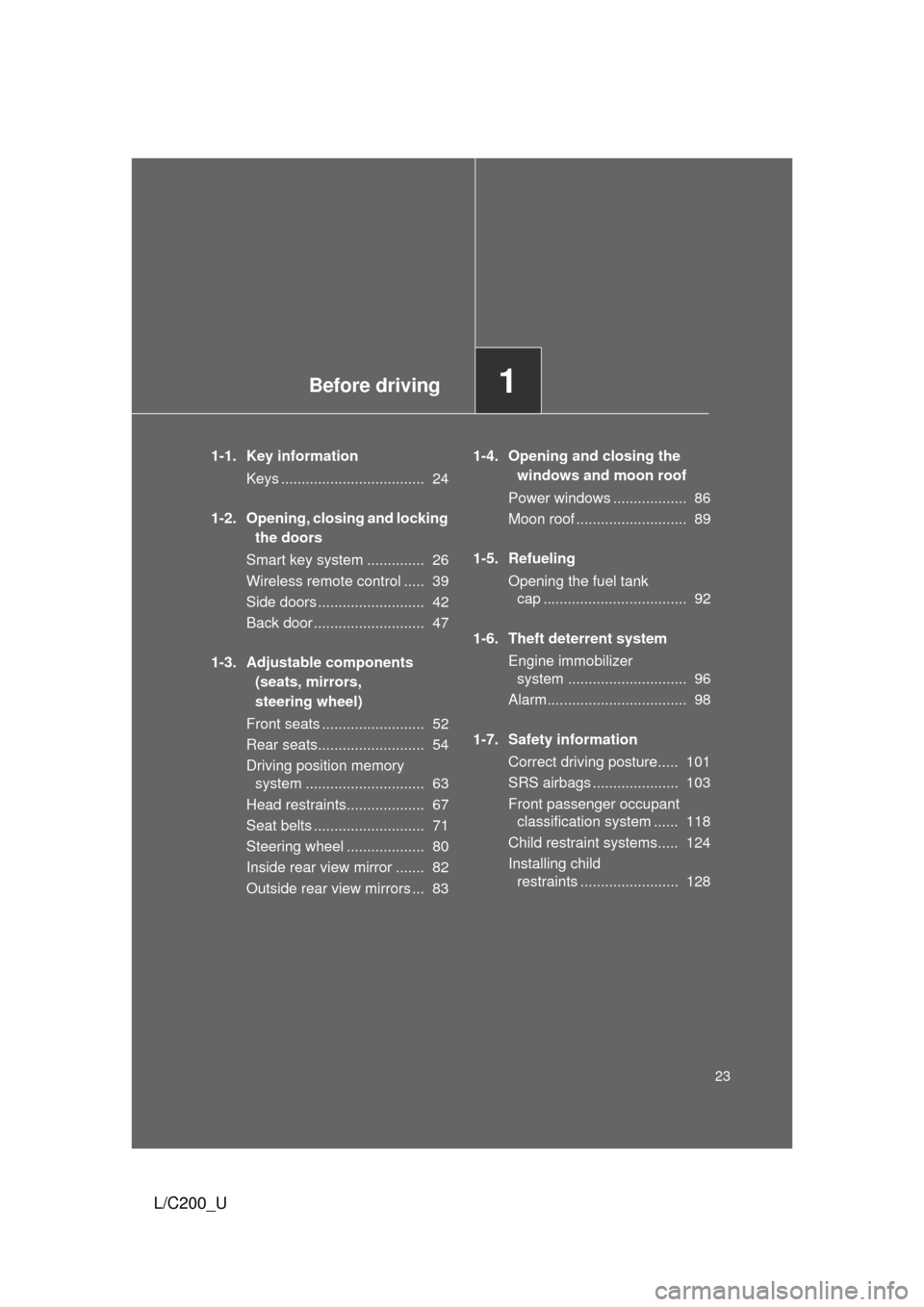
Before driving1
23
L/C200_U
1-1. Key informationKeys ................................... 24
1-2. Opening, closing and locking the doors
Smart key system .............. 26
Wireless remote control ..... 39
Side doors .......................... 42
Back door ........................... 47
1-3. Adjustable components (seats, mirrors,
steering wheel)
Front seats ......................... 52
Rear seats.......................... 54
Driving position memory system ............................. 63
Head restraints................... 67
Seat belts ........................... 71
Steering wheel ................... 80
Inside rear view mirror ....... 82
Outside rear view mirrors ... 83 1-4. Opening and closing the
windows and moon roof
Power windows .................. 86
Moon roof ........................... 89
1-5. Refueling Opening the fuel tank cap ................................... 92
1-6. Theft deterrent system Engine immobilizer system ............................. 96
Alarm.................................. 98
1-7. Safety information Correct driving posture..... 101
SRS airbags ..................... 103
Front passenger occupant classification system ...... 118
Child restraint systems..... 124
Installing child restraints ........................ 128
Page 92 of 592

92
L/C200_U
1-5. Refueling
Opening the fuel tank cap
Perform the following steps to open the fuel tank cap.
■Before refueling the vehicle
Turn the “ENGINE START STOP” switch OFF and ensure that
all the doors and windows are closed.
■ Opening the fuel tank cap
Pull the lever.
Turn the fuel tank cap slowly
to open.
Hang the fuel tank cap on the
back of the fuel filler door.
ITO15C008
STEP1
STEP2
STEP3
Page 93 of 592

93
1-5. Refueling
1
Before driving
L/C200_U
Closing the fuel tank cap
When replacing the fuel tank
cap, turn it until a clicking sound
is heard.
After releasing your hand, the cap
will turn slightly to the opposite
direction.
■Fuel types
Use unleaded gasoline. (Octane Rating 87 [Research Octane Number 91] or
higher)
■ Fuel tank capacity
Approximately 24.6 gal. (93 L, 20.5 Imp. gal.)
Page 94 of 592
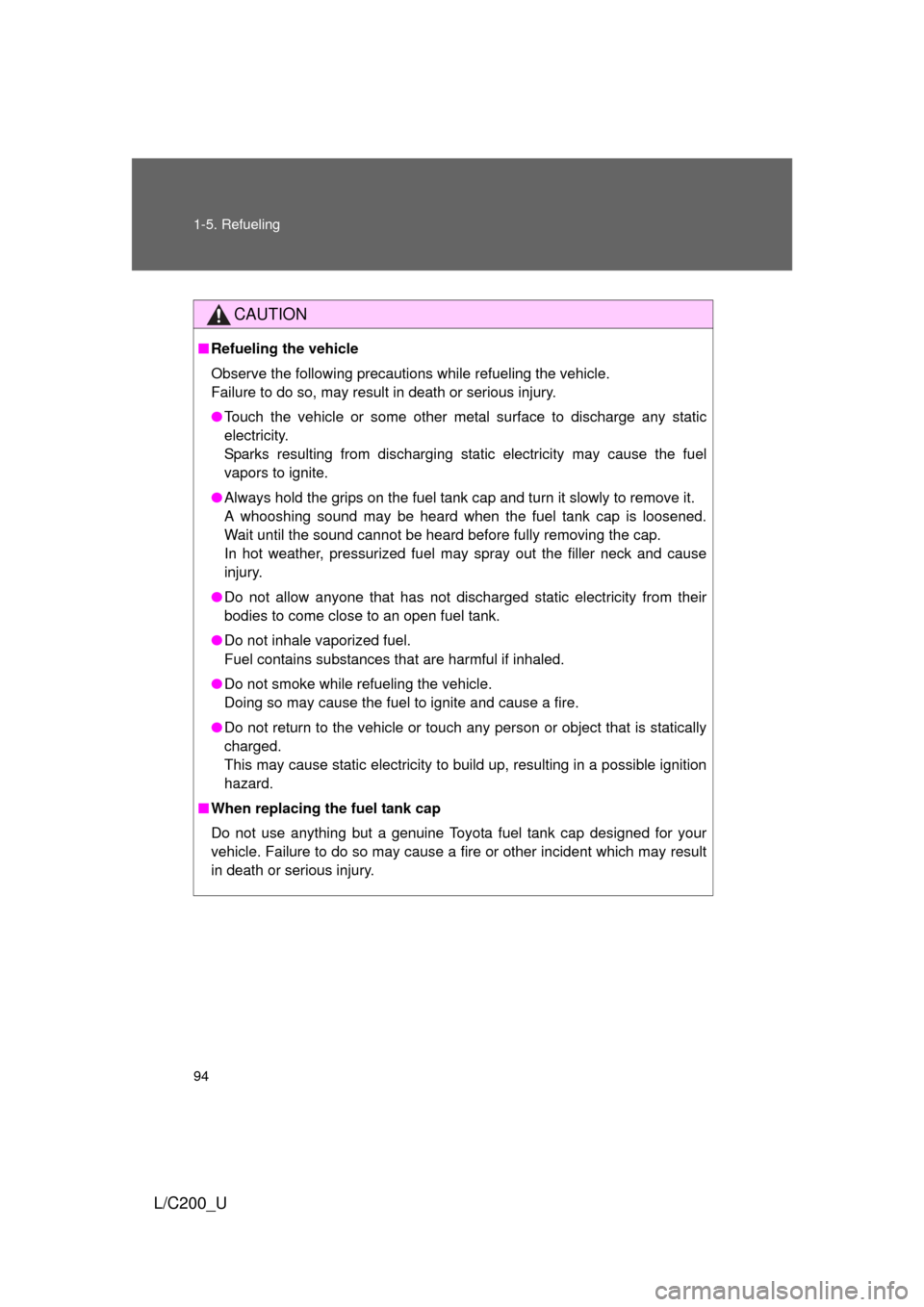
94 1-5. Refueling
L/C200_U
CAUTION
■Refueling the vehicle
Observe the following precautions while refueling the vehicle.
Failure to do so, may result in death or serious injury.
● Touch the vehicle or some other metal surface to discharge any static
electricity.
Sparks resulting from discharging static electricity may cause the fuel
vapors to ignite.
● Always hold the grips on the fuel tank cap and turn it slowly to remove it.
A whooshing sound may be heard when the fuel tank cap is loosened.
Wait until the sound cannot be heard before fully removing the cap.
In hot weather, pressurized fuel may spray out the filler neck and cause
injury.
● Do not allow anyone that has not discharged static electricity from their
bodies to come close to an open fuel tank.
● Do not inhale vaporized fuel.
Fuel contains substances that are harmful if inhaled.
● Do not smoke while refueling the vehicle.
Doing so may cause the fuel to ignite and cause a fire.
● Do not return to the vehicle or touch any person or object that is statically
charged.
This may cause static electricity to build up, resulting in a possible ignition
hazard.
■ When replacing the fuel tank cap
Do not use anything but a genuine Toyota fuel tank cap designed for your
vehicle. Failure to do so may cause a fire or other incident which may result
in death or serious injury.